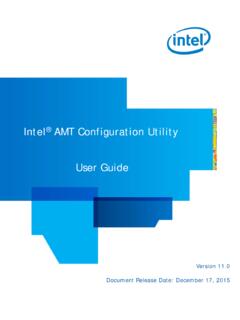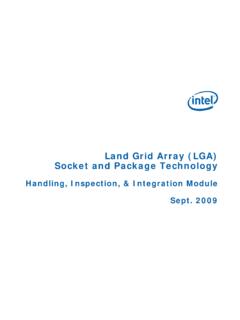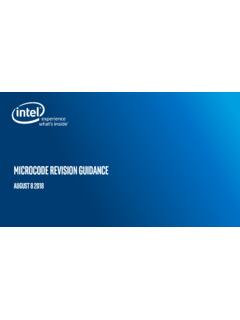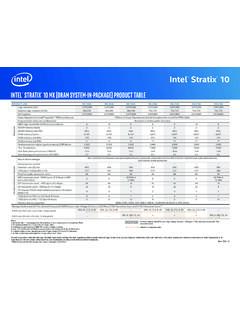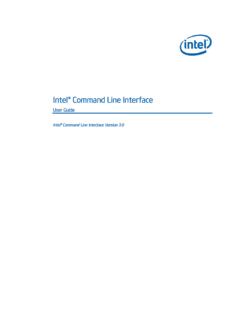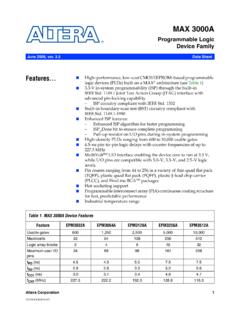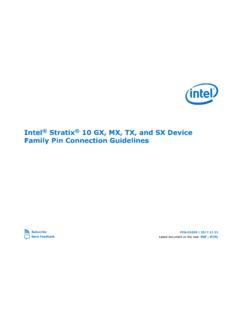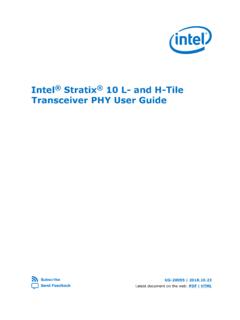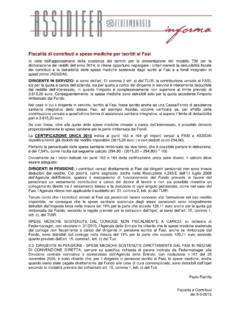Transcription of DrMOS Specifications - Intel
1 DrMOS Specifications November 2004 Revision R R 2 THIS specification [ DrMOS Specifications ] IS PROVIDED "AS IS" WITH NO WARRANTIES WHATSOEVER, INCLUDING ANY WARRANTY OF MERCHANTABILITY, NONINFRINGEMENT, FITNESS FOR ANY PARTICULAR PURPOSE, OR ANY WARRANTY OTHERWISE ARISING OUT OF ANY PROPOSAL, specification OR SAMPLE. Intel disclaims all liability, including liability for infringement of any proprietary rights, relating to use of information in this specification . No license, express or implied, by estoppel or otherwise, to any intellectual property rights is granted herein.
2 Intel may make changes to Specifications and product descriptions at any time, without notice. Designers must not rely on the absence or characteristics of any features or instructions marked "reserved" or "undefined." Intel reserves these for future definition and shall have no responsibility whatsoever for conflicts or incompatibilities arising from future changes to them. Intel and the Intel logo are trademarks or registered trademarks of Intel Corporation or its subsidiaries in the United States and other countries. *Other names and brands may be claimed as the property of others. Copyright 2004, Intel Corporation R 3 Contents 1 Introduction.
3 5 2 Background .. 6 3 Technical Specifications .. 7 Electrical Characteristics & 7 Boundary Conditions .. 8 4 Signal Description .. 12 5 Mechanical Dimensions .. 15 Appendix A Electrical & Mechanical Compatibility .. 16 Figures Figure 1. Basic Input-Output Signal Definition for a typical DrMOS .. 10 Figure 2. Recommended Input-Output Signal Interface for the DrMOS (Top View: Pin-Out as seen through the package).. 11 Figure 3. Recommended mechanical dimensions for DrMOS 15 Figure 4. Suggested Electrical Pin-Out on PCB for multiple vendor compatibility .. 16 Figure 5. Suggested Mechanical PCB Layout for Multiple Vendor 17 Tables Table 1.
4 Desired Electrical Characteristics / Features of a DrMOS device .. 7 Table 2. Pin-Out Functional Description .. 11 Table 3. Lower Gate Voltage Select Operation .. 12 Table 4. PWM Operation Description .. 14 R 4 Revision History Revision Number Description Revision Date Initial Release. November 2004 Introduction R 5 1 Introduction This document summarizes the different requirements needed to enable a standard integrated Driver-MOSFET ( DrMOS ) specification for implementation in a typical PC platform.
5 The aim of this specification is to enable features that are necessary to develop an integrated device such that inter-operability between various devices and controllers is feasible. Background R 6 2 Background The power requirements of microprocessors are increasing with every process generation. This is reflected in the increased static (steady state) and dynamic (transient) power that the processor Voltage Regulator (VR) needs to generate at very low voltages (~1V) and very high currents (100+A). This trend is foreseen to continue in the near future. The consequence of the increased power manifests itself in the form of two technology needs: A need for increased power density in the VR to satisfy higher power transfer in a limited real estate environment (such as a desktop) A need for increased efficiency at higher switching frequencies (a result of a need for faster dynamic response) to maintain losses at low levels The above two requirements have driven technology advances in the building blocks of the VR, , MOSFETs.
6 These advanced semiconductor switches have been used in synchronous buck converter, which has remained the main workhorse for the voltage regulators feeding microprocessors. Due to the lopsided nature of the voltage conversion ratio needed in the VR s, the two switches used in the VR s have been optimized for different characteristics to reduce losses. Lately the concept has been moved a step further by integrating the switches and their drivers into a DrMOS combination that have shown increased performance. Technical Specifications R 7 3 Technical Specifications The feature set for the DrMOS can be divided into two major areas.
7 They address the electrical characteristics and the thermal/mechanical characteristics of the device. These major areas of focus can be subdivided further to address many aspects of the devices Electrical Characteristics & Features The DrMOS device has been treated as a black box with some input output characteristics from an electrical characteristics perspective. The technical Specifications for the device are listed in Table 1. Table 1. Desired Electrical Characteristics / Features of a DrMOS device Parameters Typical Range Feature Remarks Switching Frequency > 500 KHz Required 1 MHz preferred.
8 > 1 MHz Fs capability acceptable Input Voltage Range 5V ~ 16V Required 12V typical input voltage assumed for desktop application. Future applications may use < 12V. Output Voltage Range ~ Required Expected output is ~1V. Future applications may have < 1V output. In such cases input voltage may be less than 12V. Continuous Output Current >25A Required 25A @ 1 MHz Fs is required. This may translate to > 25A @ a switching frequency < 1 MHz. Example 25A @ 1 MHz may mean the module is capable of 35A @ 500 KHz. Power Enable/Disable Required Logic Level input to module. Tri-state logic PWM Control Input Required Complementary Logic Level Drive Logic Select Required Logic level select for gate drive voltage Current Sense accuracy < 10% Optional Specified over a given temperature range Area/Size of the module ~ 8 mm x 8 mm Required A common footprint or motherboard interface definition is essential (critical) for adoption.
9 Testability Optional Could define test conditions to guarantee power loss at a later time Technical Specifications R 8 Thermal Characteristics/Features Maximum Power Dissipation ~3W @ 1 MHz & 25A continuous output current Actual dissipation varies based on boundary conditions. See boundary conditions listed below for the desktop application. Idea is to reduce power loss to meet desktop environment. See boundary conditions Thermal Shutdown Optional Dual Sided Cooling As needed / Optional Interface to provide heat sink on the top of the device is preferable.
10 The above table lists many of the features that are required and desired from a VR implementation perspective but is not meant to restrict the development of other design features that could possibly improve the performance of the module. The parameters in the table should be taken as a guideline given the requirements of voltage regulators in a desktop environment. It is also to be noted that the detailed electrical characteristics pertaining to switching times, logic level requirements have not been spelled out. This is to maintain the feature set at a general level so that each module developer has the freedom to innovate within a given set of features.
